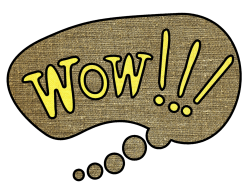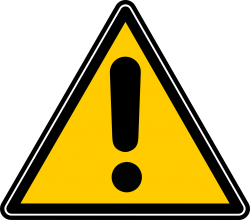
The often overused exclamation point (!) indicates strong feelings or shouting, or shows emphasis. It is sometimes used at the end of a sentence. Other times it follows an interjection (word or phrase of exclamation).
- Watch out for the falling rocks! (sentence)
- Yikes! Oh, no! (interjections)
- Watch out! (sentence)
The exclamation point, otherwise known as the exclamation mark, is often used alone to draw attention to a warning of danger or hazards. You have probably seen a yellow triangular sign with a black exclamation point on it.
Sometimes exclamation points are used at the end of a question instead of a question mark — if the sentence is exclamatory as well as a question:
- How could I have forgotten to pack underwear!
- Didn’t you see the car coming straight at you!
Here are some facts (or maybe facts) about exclamation marks:
- Several computer languages use “!” at the beginning of an expression to indicate negation: “!” A = not A
- Some languages use “!” to denote a click consonant.
- One theory of the mark’s origin is that it is derived from a Latin exclamation of joy (io).
- The modern written mark is believed to have been born in the Middle Ages when copyists wrote the Latin word io at the end of a sentence to indicate joy. The word io meant “yay.” Over time, the i moved above the o, and the o became smaller, becoming a point.
- The exclamation mark was first introduced into English printing in the 15th century and was called the “sign of admiration or exclamation.”
- There was no key on the standard manual typewriter that could make an exclamation point before the 1970s. You would have to type a period, backspace, and then type an apostrophe.
- In the 1950s, secretarial manuals in America referred to the mark as a “bang,” a precursor to the interrobang, which is a mark combining a question mark and an exclamation mark — not generally used or on keyboards.
- Thus, the exclamation mark and question mark are sometimes used together ?! It is recommended we avoid this in formal writing or any kind!
- Overly frequent use of the exclamation mark is generally considered poor writing; it should be used very sparingly.
- The exclamation point is often used in comic books.
- Studies suggest that women use exclamation points more than men do. (Perhaps women write more. Or perhaps it has something to do with the fact that women use little circles for the dots on their i’s more than men do too!)
- One study thought that exclamation points might be friendlier than periods in some cases, such as Hi! rather than Hi, or Hi.
- An exclamation point within parentheses (!) can imply that the writer has made a sarcastic comment: “Oh, I thought you were waiting for a formal invitation to visit (!)”
- F. Scott Fitzgerald said that using exclamation marks is like laughing at your own jokes.
- One exclamation point is enough to indicate surprise or emotion of some kind. However, digital communication has led to the use of multiple exclamation points in a row, as well as overuse of the mark in general. A linguist conducted a Twitter poll asking how many exclamation points were necessary to indicate genuine enthusiasm. After 800 votes, the winner was three.
- A journalism school told its students that they each had one exclamation point to use for their entire career, so use it wisely. A writer friend told me not to use more than two in a novel. The writer Elmore Leonard said, “You are allowed no more than two or three per 100,000 words of prose.”
More to Know About Exclamation Points
Some brand names and places have exclamation points included:
- Yahoo! and Joomla!
- Jeopardy! and the old TV show Shindig!
- The musicals Oklahoma!, Oliver! and Oh! Calcutta!
- Movies Airplane! and Moulin Rouge!
- The English town of Westward Ho! and a town in Quebec called Saint-Louis-du-Ha! Ha!, which is spelled with two exclamation marks.
Other Punctuation with Exclamation Points
- Put the exclamation point inside the quotation marks if it applies to the words enclosed by the quotation marks: “I smell smoke!” he yelled.
- Put the exclamation point outside the quotation marks if it applies to the entire sentence: I hot-footed it out of the building when he said, “I think I smell smoke”! (In this example, you could assume that both what he said and the whole sentence were exclamatory, in which case the exclamation point would go to its default position of inside the quotation marks.
Lesson: Don’t overuse your exclamation points in formal writing — or even in informal writing — or even in e-mails unless they are very friendly. Same with texts.
Thank you to these websites:
Stay safe and be well



Why is it considered rude to use exclamation marks in WhatsApp messages? I did that once, and I was asked why I was being rude.
I learned something about the exclamation mark in and outside the quotation marks. Thank you.
You are welcome. I know absolutely nothing about WhatsApp. I have never used it. Sorry.
The advice I give in my writers’ group and to my editing clients si to use exclamation points as if they each cost fifty dollars.
That is a good way to control the problem!
Thanks for this, Arlene.
You are very welcome. Stay safe and well, my friend!
YIKES! I’m a chronic overuser of them 😜. Try as I might, I just love them. One Amazon reviewer of my book even mentioned my overuse! (I think they were on punctuation patrol…)
I am guilty as well. Exclamation points are fun!!!!!! 🙂
Thank you!
You are very welcome. Hope you are doing well!
I never use exclamation marks in formal writing. I let the words speak for themselves. I use it rarely in informal situations, like emails.
You are doing it right! (oops)